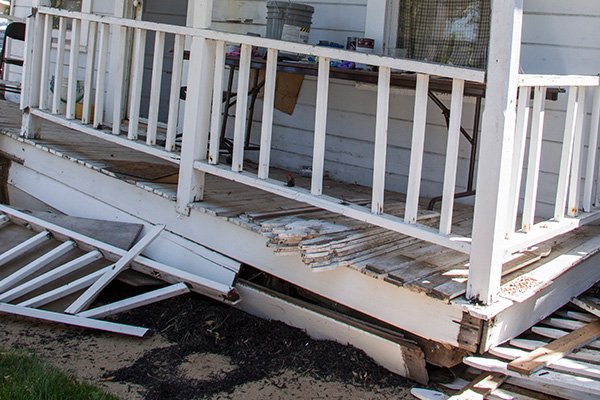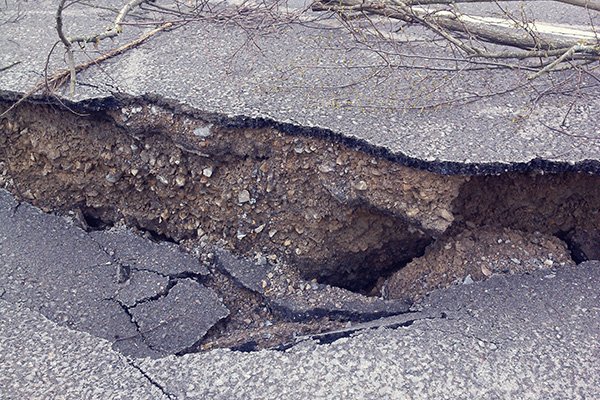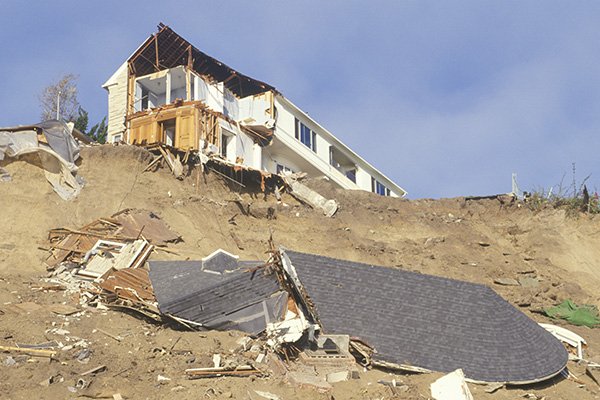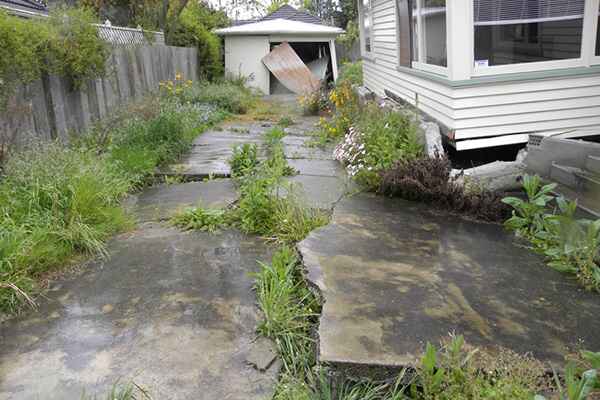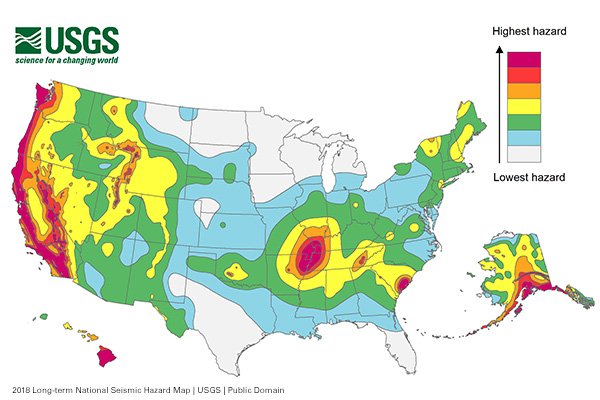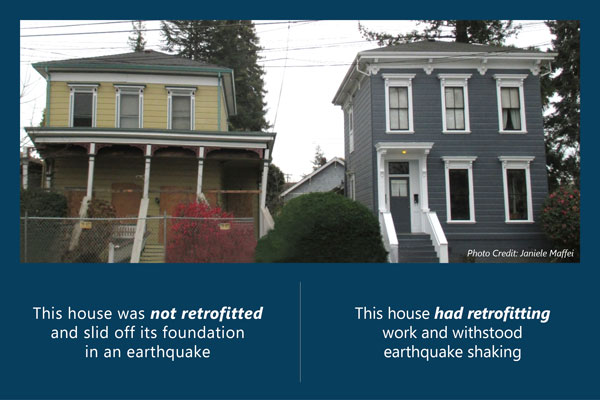An earthquake hazard is any type of physical phenomenon associated with an earthquake that may cause damage or adverse effects on the normal day-to-day activities of people. Examples of earthquake hazards include surface faulting, ground shaking, landslide, liquefaction, and surface rupture.
When we talk about earthquake hazards and earthquake impacts in this blog, we are focusing on events that may impact a region due to an earthquake, regardless of whether those events are felt by (or directly impact) people.
We also talk about earthquake risk. Risk from an earthquake focuses on what we stand to lose when the hazard occurs—it is where we live, buildings and other structures, our homes and safety, that's threatened.
Risk can usually be measured in dollar amounts or number of fatalities. Hazard is generally measured in more physical units. Seismic hazard examples are going to be based on a probability or predicted level of shaking, or extent of fault rupture, in a given area, within a certain window of time.
Primary Earthquake Hazards
Primary earthquake hazards include:
- Ground shaking, which we talk about in strength or intensity,
- Landslides, which are a downward sliding of a dry mass of the earth either from mountains or cliffs,
- Liquefaction, which is when the soil is reduced to a liquid, and
- Surface rupture, which is the breaking of the surface along a fault.
An earthquake is caused by a sudden slip on a fault. The tectonic plates are always slowly moving, but they get stuck on their edges due to friction. When the stress on the edge overcomes the friction, there is an earthquake that releases energy in waves that travel through the earth’s crust and cause the shaking that we feel.
More information about primary earthquake hazards and the effects of earthquakes can be found at the U.S. Geological Survey website.
Ground Shaking Hazard
An earthquake generates seismic waves that cause ground motion as they pass through the area. As those waves pass near or underneath your house, your house can move from side to side and up and down. The type of shaking your house experiences depends on how far it is from the fault and the soil under and around it.
Surface Rupture Hazard
An earthquake can push and pull the ground, tearing the surface and pushing the ground apart and upward. These are known as “surface ruptures.” A surface rupture may occur suddenly during an earthquake, or it can happen more slowly—in either case, surface ruptures often happen along pre-existing faults. If it happens close to your home, it can cause considerable damage to structures and to the nearby land.
Landslide Hazards
Earthquakes often trigger landslides, which cause significant—and often even catastrophic—damage to houses.
The well-remembered 1994 magnitude 6.7 Northridge earthquake triggered over 11,000 landslides! This contributed to the total $20 billion in property damage caused by this one earthquake.
If your house is in the path of an earthquake-induced landslide, it is at risk for damage and may end up sliding downhill.
id="liquefaction"
Liquefaction Hazard
Earthquake motion can turn loosely packed, water saturated soil to liquid—this is called liquefaction. Liquefied soil loses its density and, ultimately, the ability to support roads, buried pipes and houses.
If liquefaction occurs on or near your property, your house may sink possibly by several feet and be surrounded by or filled with liquified soil. The California Governor’s Office of Emergency Services My Hazards tool can help you identify geologic hazards near your house.
Secondary Earthquake Hazards
Secondary earthquake hazards are caused by a consequence of the ground shaking, which is caused by earthquakes. These secondary earthquake hazards can result in tsunamis, seiches, floods and fires.
Tsunamis
A tsunami is a giant wave (or series of waves) created by an undersea earthquake, volcanic eruption or landslide. More than 80 tsunamis have been recorded over the past 150 years in California. Tsunamis in California are not common and, for the most part, have caused little or no damage when they have occurred. The last tsunami to hit California came from Japan following a magnitude 9.0 earthquake in 2011. That earthquake triggered a massive wave that traveled 5,000 miles and damaged more than 100 boats in Santa Cruz.
Seiche
Seismic seiches are standing waves set up on rivers, reservoirs, ponds and lakes when seismic waves from an earthquake pass through the area. They are in direct contrast from tsunamis, which are giant sea waves created by the sudden uplift of the sea floor often following an undersea earthquake.
Flooding
Earthquakes also can cause flooding in several ways.
They can result in broken dams and levees on rivers. When an earthquake occurs, the integrity of these structures may be damaged, potentially causing flooding in nearby lowland areas.
For residential structures, the shaking from an earthquake can cause water pipes to crack, break or burst, causing water damage to homes, basements, or the exterior grounds. If a water heater is not properly braced, it can also fall, causing further damage.
Fires
Why do earthquakes often cause damaging fires? Earthquake shaking causes movement, sometimes resulting in damage to homes, personal equipment and contents. This movement can result in released flammable gases or liquids and other combustible material, which can come into contact with an ignition source such as open flames or electrical arcing.
Fires, often associated with broken electrical and gas lines, are one of the most common side effects of earthquakes. Gas is set free as gas lines are broken, and a spark can start a fire. To complicate things, earthquakes can cause water lines to break, so there is no water source to extinguish the fire.
Homeowners should consider installation of an automatic shut off valve for their gas line, which automatically shuts off the gas when a major earthquake occurs. Learn more about gas safety.
Earthquake Hazards Map
With 15,700 known earthquake faults in California and more than 500 active earthquake faults in the Golden State, most of us Californians live within 30 miles of an active fault. From coastal areas to urban cities, scientists tell us that there is a 99 percent chance that at least one major earthquake is going to occur in our state in the next 30 years.*
An earthquake hazards map, like the one found on the U.S. Geological Survey website, provides seismic hazards mapping information to make you aware of and help you become familiar with the earthquake hazards in your specific area.
Another effective tool for the public to use to discover hazards that exist in their area and learn how to reduce those risks can be found at www.myhazards.caloes.ca.gov.
What is your Earthquake Risk?
Every area of California has earthquake risk. The Golden State has more than 15,700 known earthquake faults and more are being discovered. One of California’s most devastating and strong earthquakes occurred in January 1994 in the San Fernando Valley community of Northridge, on a fault that was unknown at the time. We know it’s not a matter of if, but when, future earthquakes will occur.
Begin preparing for an earthquake by knowing your home’s weak spots and what earthquake hazards are near your home. The U.S. Geological Survey website has an interactive fault map that can help you learn what faults run through your area.
How to keep your family safe during an earthquake
There are other ways in which you can protect your home and your family in the event of a major earthquake. They include:
- Properly strap and secure water heaters and gas appliances to wall studs. Have a professional install flexible fittings to avoid gas or water leaks.
- Do not hang heavy items, such as pictures and mirrors, near beds, couches or anywhere people sleep or sit.
- Install strong latches or bolts on cabinets. Large or heavy items should be closest to the floor.
- Learn how to shut off the gas valves in your home and keep a wrench handy for that purpose.
- Place large and heavy objects and breakable items on lower shelves.
- Anchor overhead fixtures to joists.
- Anchor top-heavy, tall and freestanding furniture, such as bookcases and china cabinets, to wall studs to keep these from toppling over.
- Ask about home repair and strengthening tips for exterior home features, such as porches, decks, sliding glass doors, canopies, carports and garage doors.
- Go to www.redcross.org for more useful information and tips.
Learn the seven steps to earthquake safety
No one can predict when or where an earthquake will strike, but you and your family can be prepared before the next big one hits. The following earthquake preparation tips can help you create a plan and organize supplies that will keep you safer. These seven steps can be found on our Earthquake Safety Steps page.
Step 1: Secure your space by identifying earthquake hazards.
Step 2: Plan to be safe by creating a disaster plan and deciding how you will communicate in an emergency.
Step 3: Organize disaster supplies in convenient locations.
Step 4: Minimize financial hardship by organizing important documents, strengthening your property and considering insurance.
Step 6: Improve safety after earthquakes by evacuating if necessary, helping the injured and preventing further damage.
Step 7: Reconnect and restore daily life by communicating with others, repairing damage and rebuilding community.
How to protect your home from earthquakes and earthquake hazard
Even though it is impossible to accurately predict when an earthquake will occur, you can still take measures to reduce damage and improve the chances of staying safe by preparing in advance for earthquakes and earthquake hazards. The ways in which you can protect your home and your family in the event of a major earthquake include:
- Create an earthquake safety plan for you and loved ones, including pets.
- Know your risk for earthquakes in your area and what you must do to stay safe.
- Make or purchase earthquake safety kits.
- Find out if your home needs seismic retrofitting.
- Identify and fix potential earthquake hazards in your home.
- Securing fixtures, furniture, appliances and other items inside your home.
For more safety, protection and emergency preparedness tips, go to our Resources page.
Determine your structural risks
If you live in California and your raised foundation house was built before 1980, earthquake experts say your home may be especially vulnerable to damage from earthquake shaking because it was built before modern seismic building codes were put in place. The frames of many of these type homes are not bolted to their foundations. And without adequate bracing and bolting, these houses can slide or topple off their foundation during an earthquake.
Look up your house type to learn its vulnerabilities and more about how to strengthen your house.
Consider a seismic retrofit
Strengthening your house with a seismic retrofit is a good way to help prevent costly earthquake damage. It can provide peace of mind, knowing that you have helped your family better withstand an earthquake by strengthening where you live.
The retrofitting process itself can be straightforward and often not as intrusive as homeowners might think. Depending on the type of retrofit needed, the work usually can be done in a few days and homeowners can remain inside their dwelling as workers do the retrofitting without entering the residence. If your house is older, odds are it may need to be seismically retrofitted. A retrofit is a worthwhile investment to help it have a better chance to withstand earthquake damage.
*According to the third Uniform California Earthquake Rupture Forecast (UCERF3) report.

